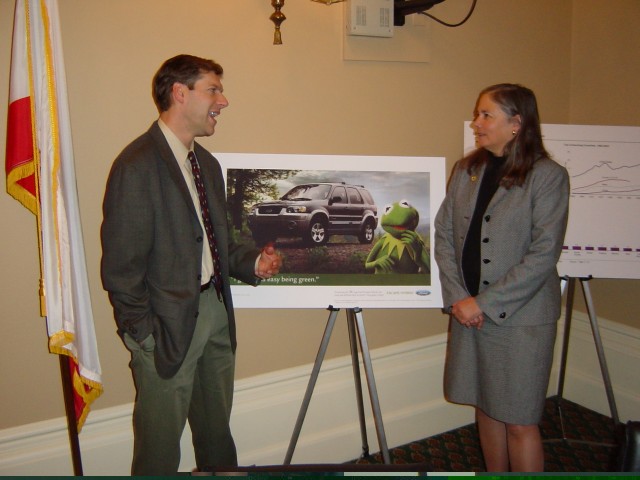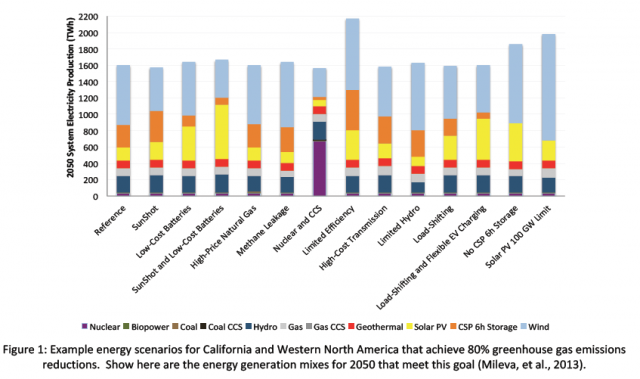April 29, 2015 Testimony of Professor Daniel M. Kammen[1]
on
SB 32: Climate Pollution Reduction Beyond 2020: Healthier Communities and a Stronger Economy[2]
The Global Warming Solutions Act (Pavely-Nunez 2006) established a framework to reduce California’s greenhouse gas emissions to the 1990 levels by 2020, or by roughly 80 million metric tons of carbon dioxide equivalent (MMT CO2e). AB32 built on California’s long history of energy, environmental and public health leadership. California is on path and pace to achieve these milestones in achieving climate protection, based on a series of mutually supporting policies, which include: a renewable energy portfolio standard (RPS); a low-carbon fuel standard; and a suite of building, appliance, water and other efficiency standards; low-carbon transportation policies.
The green jobs benefit: California’s leadership in defining and working to achieve these goals, as well as in establishing important milestones for distributed solar energy and electric vehicle deployment among other targets has created a climate of innovation, job creation, and global leadership. This effort has demonstrably led to significant job creation, reduced health costs through a cleaner environment, and significant and ongoing creation of new companies, wealth, and intellectual property. The job creation alone that has resulted from this program has been well documented (see: https://rael.berkeley.edu/project/green-jobs/).[3]
The return to the 1990 emission baseline is only a first step in meaningful climate protection, but one that California has demonstrated can be achieved with positive effects on the state economy, and with significant quantifiable benefits for human and environmental health, as well as reduced long-term and catastrophic risks to the state’s key industries, infrastructure, and quality of life. SB32 would extend the mission of innovation, job-creation, and global leadership to meet the 80% emissions reduction goal that has been identified by the Intergovernmental Panel on Climate Change and many other scientific assessments as a necessary level of climate protection.
California and the global climate objective: While California is under 2% of total anthropogenic greenhouse gas emissions, it plays a critical role in achieving the global goal of 80% or more emissions reduction. In the last year we have seen significant steps forward to meet the worldwide process of emissions reductions in the form of a US-China climate accord, which utilizes significant elements of the California AB32/SB32 process. Recently Mexico announced a 25% emissions reduction commitment, with further targets possible if cooperative global actions are taken as well. The Mexican emissions target is based in part on coordination and alignment with the climate goals of California.
The positive economics of SB32: A number of assessments of the technical feasibility and economic impact of meeting both the AB32 and SB32 goals have been completed and are underway. In the energy system modeling work in my laboratory, we have found that a diverse set of pathways are possible that all meet the 2020, 2030, 2040, and 2050 climate goals.[4] A key finding of this work is that except for cases where energy efficiency is not aggressively pursued, the costs of meeting clean energy targets presented by Governor Brown for 2030 and the 80% reduction target for 2050 are all technically achievable and economically reasonable (Figure 1). In fact, a number of the low-carbon 2050 pathways are less costly than what electricity is forecast to cost without a climate target.
California’s climate targets create jobs and economic growth: The key lesson from the work of my laboratory and many other groups is that coordination across the energy, transportation, building, agricultural, and other sectors is vital to achieve these goals in an economically efficient fashion. In fact the job creation in the form of direct employment but also, critically, in wealth creation through new innovative companies is a true, lasting, and global benefit of the process that AB32 started and SB32 would continue.
References:
[1] Daniel Kammen is Professor of Energy at the University of California Berkeley with appointments in the Energy and Resources Group, the Goldman School of Public Policy, and the Department of Nuclear Engineering. He is the director of the Renewable and Appropriate Energy Laboratory (rael.berkeley.edu), and a Coordinating Lead Author for the Intergovernmental Panel on Climate Change, which shared the 2007 Nobel Peace Prize. Email: Kammen@berkeley.edu
[2] SB32 Author: Senator Fran Pavley, with Co-Authors: Senators Allen, Beall, Block, De León, Hancock, Hill, Jackson, Leno, Liu, McGuire, Monning, And Wolk, and Assembly Members Bloom, Cristina Garcia, Rendon, And Mark Stone.
[3] Wei, M., Patadia, S. and Kammen, D. M. (2010) “Putting renewables and energy efficiency to work: How many jobs can the clean energy industry generate in the U. S.?” Energy Policy, 38, 919 — 931.
[4] Mileva, A., Nelson, J. H., Johnston, J., and Kammen, D. M. (2013) “SunShot Solar Power Reduces Costs and Uncertainty in Future Low-Carbon Electricity Systems,” Environmental Science & Technology, 47 (16), 9053 – 9060.


You must be logged in to post a comment.